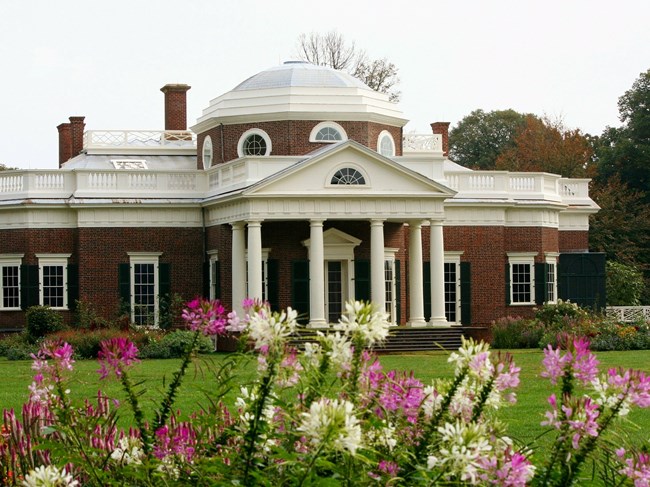Last updated: July 15, 2020
Article
Monticello and the University of Virginia in Charlottesville: World Heritage Site

Thomas Jefferson (1743–1826) was the author of the American Declaration of Independence, third president of the United States, and a talented architect of neoclassical buildings. It is for this architectural distinction that Jefferson’s plantation home, Monticello, and his ideal "academical village" -- the heart of the University of Virginia -- are included on the World Heritage List. Jefferson's use of an architectural vocabulary based upon classical antiquity symbolizes both the aspirations of the new American republic as the inheritor of European tradition and the cultural experimentation that could be expected as the country matured.
In 1809, Jefferson finished the rebuilding of Monticello begun in 1796. He transformed the original eight room Palladian villa, with its tall two-story portico, into a 21-room house designed in the fashionable Neoclassical style he saw in France. The front elevation was a deceptively low horizontal composition centered on a pavilion dominated by a columned portico and a low dome. The renovation kept most of the rooms of the original house, but more than doubled its depth. The integration of the buildings into the natural landscape, the originality of the plan and design, and the refined proportions and decor make Monticello an outstanding example of a neoclassical work of art. Jefferson, an avid horticulturist, also created the gardens at Monticello, which were a botanic showpiece, a source of food, and an experimental laboratory of ornamental and useful plants from around the world.
The University of Virginia was Jefferson's most ambitious and last architectural undertaking. This project departs from preexisting British or American college planning schemes. Jefferson intended that the university design express educational ideals both encyclopedic and democratic, a fitting legacy for his beloved Virginia and the new United States of America.
Jefferson founded the University of Virginia in 1819 as the first nonsectarian university in the United States. He intended the institution to produce leaders well-versed in public service and practical affairs. The University of Virginia is considered one of Jefferson’s greatest achievements, both for its architecture and innovative nature. The first university to use an elective course system, its most recognizable physical symbol is the Rotunda, which Jefferson designed to contain the library and be the heart of the campus. Standing at the north end of the University’s Lawn with its flanking faculty pavilions and student rooms, the Rotunda is based on the Pantheon in Rome. Its Lawn continues to serve as a model for centralized green areas on university campuses. Reconstructed in 1899, after being severely damaged in a fire, the Rotunda retains many of its original Jeffersonian design elements and remains a physical embodiment of his illustrious legacy.
Visitors to Thomas Jefferson’s Monticello can explore both the house and extensive grounds. A day pass to the site allows visitors to choose from a selection of guided tours ranging in topic from a standard house tour to a themed “Slavery at Monticello” or “Garden and Grounds” tour. At Monticello’s grounds, guests may visit the estate's historic gardens, walk along Mulberry Row – once the hub of plantation activity – or hike the scenic Saunders-Monticello Trail. The visitor center features a series of museum-style exhibits, a hands-on activity area geared towards younger visitors, and a café whose menu includes seasonally-grown vegetables from the Monticello Vegetable Garden.
A short driving distance from Monticello, the University of Virginia is an active college campus. Guided tours of the university’s famous Rotunda, Academical Village, and Lawns are typically available free for visitors.
Thomas Jefferson’s Monticello, a World Heritage Site, and a National Historic Landmark, is located at 931 Thomas Jefferson Parkway, Charlottesville, VA. Monticello is also a National Historic Landmark. Click here for the National Historic Landmark registration file: text and photos.
The University of Virginia, a World Heritage Site and a National Historic Landmark, is located in downtown Charlottesville, VA. Click here for the National Register of Historic Places file: text and photos.
